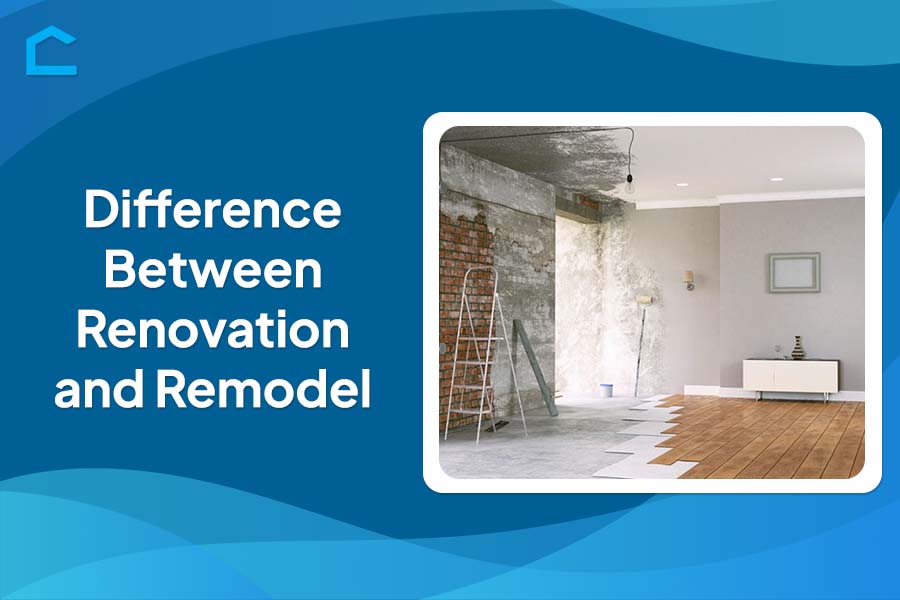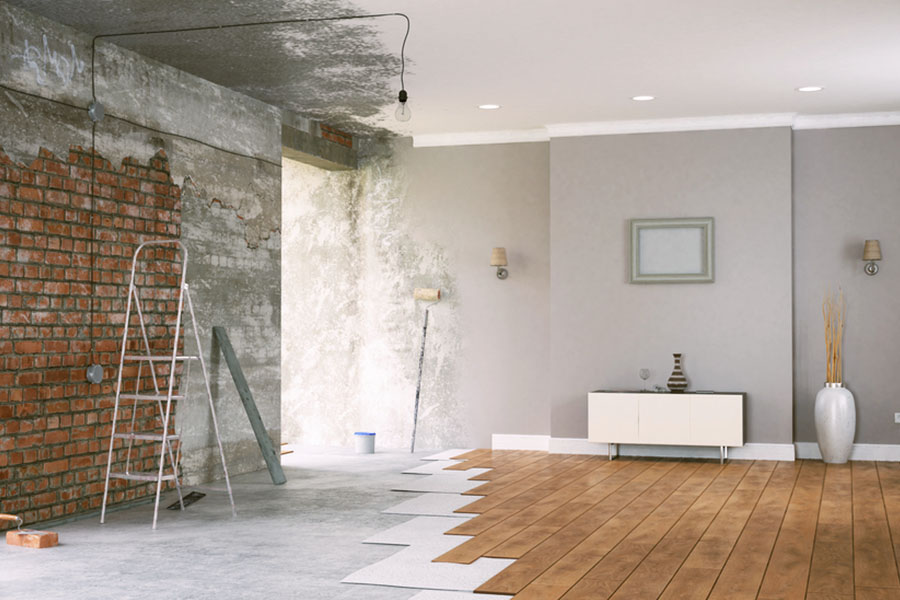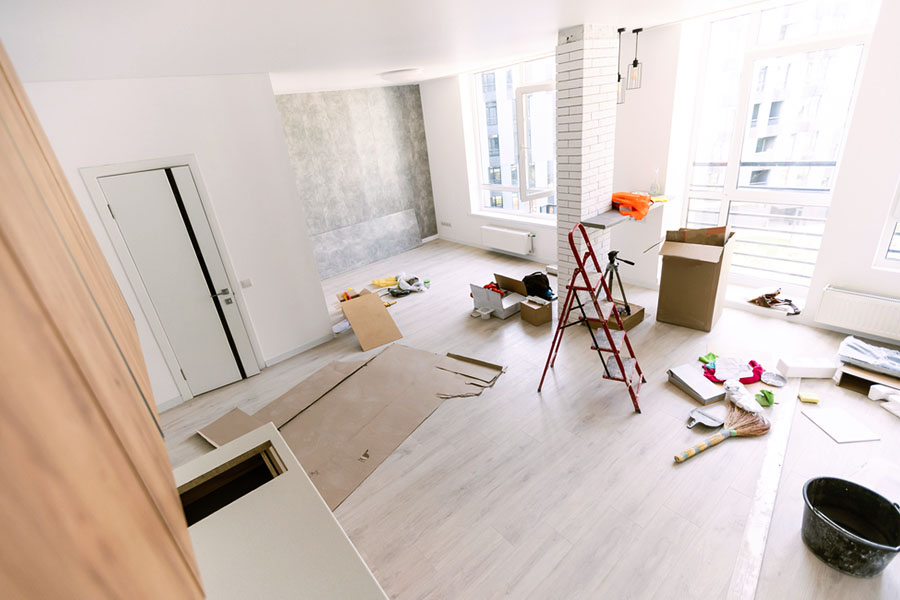Difference Between Renovation and Remodel

When it comes to home improvement projects, the terms “renovation” and “remodel” are often used interchangeably. However, these two concepts are not quite the same. While both involve changing your living space, the scope and extent of work can vary greatly. So, what is the difference between renovation and remodel?
Understanding the distinction between a renovation and a remodel is crucial for effective planning and budgeting. In this comprehensive guide, we’ll explore the key factors that set these two undertakings apart.
Whether you’re a homeowner considering a major overhaul or a real estate professional advising clients, this article will provide valuable insights to help you navigate the complexities and understand the nuances that differentiate a renovation from a remodel. Let’s start!

Difference Between Renovation and Remodel
Renovation involves making improvements or repairs to existing features. This may include updating fixtures or repainting walls. However, it typically does not involve fundamentally altering the layout or structure.
On the other hand, remodeling involves significant changes to the space’s design or function. This can include restructuring the layout, adding or removing walls, or installing new features. So, what’s the difference between a renovation and a remodel?
While both contribute to enhancing your home, renovation focuses on refreshing or enhancing what’s already there, and remodeling involves more extensive modifications. Remodeling aims to transform the space according to new preferences or needs.
Scope of changes
Renovation
Renovations mainly aim to improve the look of existing spaces without changing their basic structure. These projects often involve simple upgrades like painting walls, new flooring, or updating old fixtures. They may also include fixing drywall, refinishing cabinets, or upgrading lighting and window treatments.
Common examples of renovation projects include updating kitchens or bathrooms by changing countertops, sinks, appliances, or tiles. Although renovations can make a space feel fresh, they usually don’t alter the overall layout or flow of rooms.
Remodel
Remodeling involves making significant structural changes that reshape the layout and size of a space. This often means removing, moving, or putting in walls, doors, or windows to change how rooms flow and function.
Remodeling projects often involve merging smaller rooms into one open living space, dividing larger rooms to create new ones, or increasing the size of a home through additions or bump-outs. For instance, converting an attic or basement into usable space is a typical remodeling project.
Other common remodeling projects include adding dormers or altering the roofline for second-story expansions. These major structural changes can dramatically alter how a space is used and felt.
Purpose
The main goal is to enhance the appearance of a space by making updates while keeping the existing layout. Renovations involve replacing old fixtures, finishes, or materials to give the area a fresh look while maintaining its functionality and original charm.
A remodel aims to enhance functionality by adjusting spaces to meet the evolving needs of modern living standards. As time passes, the original floor plans may no longer be practical.
Remodeling involves making structural changes to update outdated designs. This can include removing walls, relocating rooms, or adding more space to increase efficiency and comfort.
Extent of work
Renovation
Renovations usually mean making surface-level changes like painting, installing new floors, and updating fixtures and finishes. Due to their focused nature, renovation projects often finish quickly.
For instance, a small kitchen or bathroom renovation might only last a few weeks, while bigger room renovations might take a few months. Common renovation tasks include upgrading kitchen cabinets, countertops, and appliances.
Another example involves redoing a bathroom by putting in new tiles and fixtures. Refinishing hardwood floors and repainting several rooms in a house are also typical renovation projects.

Remodel
Remodeling projects often involve extensive work compared to simple renovations. This work includes making structural changes and updating systems like plumbing and electrical wiring.
The increased complexity means rearranging room layouts, moving walls, doors, and windows, and sometimes even tearing down parts of the structure. Hence, remodeling projects often take longer to complete, spanning several months to a year.
To efficiently carry out complex remodeling projects, careful planning and strategic execution are necessary. Examples of such projects are diverse.
For instance, one common approach is to merge the kitchen and living room to create an open-concept space. Another involves constructing a second story to add new bedrooms and bathrooms.
Converting an unfinished basement into usable living space is also a common complex remodeling project. Additionally, relocating the laundry room and adjusting the layout of nearby spaces are examples of complex remodels.
Considerations When Deciding
When you’re deciding between renovating or remodeling, there are some important things to consider. Renovations usually cost less because they involve fewer changes to the structure and can be done in smaller steps.
Remodels, on the other hand, require more extensive work, like changing the structure and systems such as plumbing and electrical, which can make them much more expensive. Renovations are also quicker because they focus on smaller areas, causing less disruption.
Remodels can take a lot longer because they involve major changes like tearing down walls and modifying systems. That can make living conditions uncomfortable for a while.
You need to figure out what you want to achieve – whether it’s just making things look better or improving functionality. Renovations are good for improving appearances while keeping the original layout, while remodeling allows you to create modern spaces that fit your needs better.
Ultimately, you need to decide which option – renovation or remodeling – fits best with what you want for your home in the long term.

Conclusion
As we come to an end, understanding the difference between renovation and remodel is essential for homeowners embarking on any home improvement project. We hope this article helped you comprehend the nuances that distinguish these two approaches.
Renovations focus on aesthetic updates within existing layouts, while remodels involve structural changes to optimize functionality and adapt to evolving needs. As you plan your next home endeavor, carefully assess your budget, timeline, and desired outcomes.
Determine whether a renovation or a comprehensive remodel best aligns with your vision. With this knowledge, you can confidently make informed decisions to create a living space that reflects your lifestyle and personal preferences.
